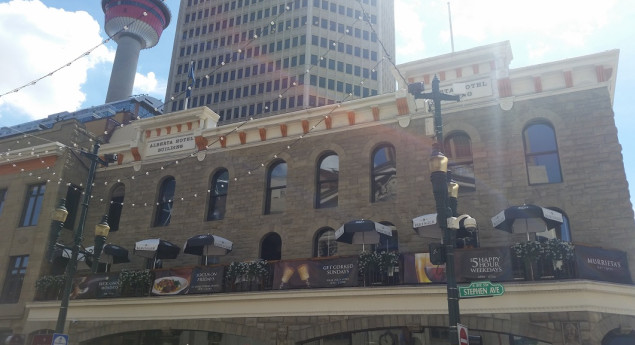The Alberta Hotel, originally built 1888-90, is a sandstone retail and commercial building within the Stephen Avenue National Historic District of downtown Calgary. The three storey, ltalianate-style, landmark building occupies a corner location at one of downtown’s busiest intersections. The building also incorporates a 1906 Classical Revival-style annex and 1891 rear addition. The earliest part of the building is distinguished by its rock-faced exterior, roundheaded windows and ornamental metal cornice, while the annex is defined by a smooth-finished, ashlar facade.
The Alberta Hotel, opened in 1890, is symbolically important for its central association with Calgary’s pioneer-era history, being the city’s pre-eminent hostelry and its oldest remaining hotel building. Occupying a corner at one of downtown’s most prominent intersections, this sandstone landmark served as Calgary’s most famed hotel until its closing in 1916. For most of the building’s history as a hotel, it claimed the status as being the best in the city, and was a social crossroads. During this period the hotel was the preferred lodging and gathering place for well-to-do ranchers, businessmen, local personalities and remittance men earning it the status as a ‘male Mecca’. Apart from the superior accommodations provided by the hotel, its other drawing cards included an excellent dining room, a favored barbershop, a pool and billiards room, a reading room and a renowned beverage room, famous for its 125 foot-long bar-supposedly the longest between Winnipeg and Vancouver. Some of the well-known cattlemen and personalities that regularly patronized the Alberta Hotel included George Lane, owner of the Bar-U Ranch; Fred Stimson, manager of the Bar-U; brewer, A.E. Cross; rancher, William Roper Hull; and meatpacking king, Pat Burns. It is reputed that the idea of the Calgary Stampede was conceived in Lane’s room here in 1912. RB. Bennett, an important Calgary attorney and later Prime Minister of Canada (1930-35) lived in the hotel for 22 years and dined at the same table daily.
Architecturally, the Alberta Hotel is significant as one of the oldest structures in downtown Calgary and is distinguished by its use of local sandstone in its construction. Construction of the original portion of the building was initiated in 1888 and reflects the changes to occur to downtown building practices as a result of the ‘Great Fire’ that leveled Calgary’s downtown two years earlier. Subsequent to the fire, and prior to World War I, much of downtown was rebuilt using local sandstone, earning Calgary the nickname, ‘Sandstone City’, with the Alberta Hotel being a key, remaining contributor to that characterization. While some of these buildings were simply clad or detailed in sandstone, the original portion of the Alberta Hotel is of solid sandstone construction and is among the earliest substantial buildings to be built after the fire. Andrew Kennedy, a Quebec contractor, was in charge of construction. An addition was made to the rear of the building in 1891 and a 1906 building was later annexed.
The original portion of the Alberta Hotel is unique as a superior and rare example of the Italianate style of design in Calgary. Few buildings in Calgary, especially commercial, were built in the style and even fewer remain. The ground-floor of the original building has been altered, but the second and third-storey exterior retain their distinctive rock faced sandstone appearance, round-headed windows and its ornamental, bracketed metal cornice. Willcox & Johnson, of St. Paul, Minnesota, were responsible for the original design. These architects were individually and jointly responsible for many impressive buildings around the U.S.A. including the Nebraska State Capitol (1882). The Alberta Hotel is their only known Canadian commission. Further, the 1906 annex is a fine, early example of Classical Revival-style architecture in the city.
The Alberta Hotel has long been an important landmark in downtown Calgary due to its commanding and central location, long-time presence, distinctive architecture and its integral role in Calgary’s history and social life, Historically, Calgarians knew the building as a favorite meeting location, calling it the ‘Alberta corner’. This is where women would stand to meet friends, downtown, and where business men would wait to meet associates for appointments. In the early part of the twentieth century it was said that if you were trying to find someone, that by waiting at the Alberta, they would eventually show up or pass by.
Earn 10 points!









